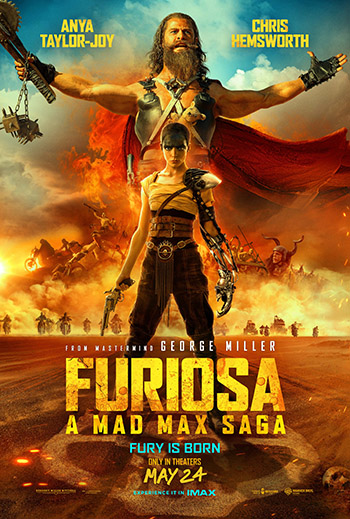Movies

New Releases • A-D • E-H • I-P • Q-Z • Articles • Festivals • Interviews • Dark Knight • Indiana Jones • John Wick • MCU
George Miller’s Furiosa: A Mad Max Saga, starring Anya Taylor-Joy and Chris Hemsworth
Trailer: Warner Bros.
Furiosa: A Mad Max Saga
Directed by George Miller
Rated R
Driven 24 May 2024
#Furiosa • #IMAX
It’s a longer road, but Furiosa still packs a mighty fury.
The Road War

Ostensibly, Furiosa is about a peach pit and a forearm.
While it’s not entirely necessary to watch the other episodes in the “Mad Max saga” to appreciate what Furiosa is all about, there is an advantage to being familiar with Mad Max: Fury Road, to which Furiosa is a prequel. Particularly when it comes to the forearm. (The peach pit will come later.)
In Fury Road, Imperator Furiosa, played by Charlize Theron, crosses paths with Max Rockatansky (Tom Hardy) and, joining forces, they take down the empire of Immortan Joe (Hugh Keats-Byrne).
Imperator Furiosa, curiously enough, sports a mechanical left forearm. Her quest is to make her way back home to a secret place of abundance, but it’s a treacherous journey made all the more complicated by the fact the flesh missing from her forearm was decorated with a tattoo artfully providing reminders of home.
Furiosa backs up and tells the story of her homeland, that fertile place of peaches and greenery, along with that forearm, its tattoo and their grisly loss.
Victory Road
It’s too easy to forget eight years ago Fury Road was honored with 10 Academy Award nominations, including Best Picture and Best Director. It walked away with six from the more technical categories. It’s not just a masterpiece, it’s a Maxterpiece of action movie bliss. And it was an epic, 30-year journey for George Miller to get the movie made. Now a remarkably 79 years young, Miller is still at the top of his game, even after directing children’s fare like Babe: Pig in the City and two Happy Feet cartoons (or, animated features, if you prefer). Miller plays in a much different field from other masters, such as Martin Scorsese and Steven Spielberg. And that’s not to mention he was a doctor before he became a movie director.
Miller’s violent, action-packed gearhead series, dating back to the original Mad Max in 1979, is set in a post-apocalyptic world in which gasoline and the combustion engine (along with bushels of testosterone) rule all. But that’s also where Fury Road and Furiosa take a sharp turn.
From a certain point of view, the latest two installments are a tribute to mothers and motherhood. They raise children and create a civil society, but they are also sharpshooters and experts at motorcycle repair.
In the case of Furiosa — whether it’s Theron in Fury Road or Anya Taylor-Joy in Furiosa — she’s also a mighty strong badass who can stand toe-to-toe with Max and any given musclehead who stands in her way. She’s even described as “the fifth Rider of the Apocalypse.”
Lessons from the Wasteland
There’s still plenty of testosterone. In Furiosa, it’s supplied in large part by Dementus, a strange man with a taste for theatrical wardrobes and a case of post-apocalypse megalomania (he even rides in a three-bike motorcycle chariot that itself is a blast to behold). He wants to rule the wasteland, but he’s a horrible leader, not to mention a horrible person (personal observation: the traits seem to go hand-in-hand).
Chris Hemsworth trades in his Thor cape and hammer for a blood-soaked cloak and a Teddy bear tied to his belly. Hemsworth also hides behind a nose job and a strange, unidentifiable accent. Maybe it’s more like a vocal affectation.
But wait. A Teddy bear? There’s a lot of quirkiness to be had in any given moment of the Mad Max saga, but a Teddy bear? Well, yeah. He was a father of a couple children. The Teddy bear’s a reminder of their lives and loss.
That could’ve been an inroad to a sympathetic character, but Dementus is simply a bad person through-and-through; he serves as a recurring obstacle in Furiosa’s trek home. Actually, he’s responsible for her being separated from her home and mother in the first place. And much, much worse.
House of Holy Motors
Looking back on the original Mad Max trilogy starring Mel Gibson, the movies hold up well enough. Beyond Thunderdome in particular seems even stronger now than it has in the past. But all three movies are so modest in their budgets and production values compared to Fury Road and now Furiosa. The original Gibsons are action-focused, but the new installments are pedal-to-the-metal symphonies of action bolstered by incredible stunt work performed by very real human beings instead of pixilated CGI mimicry.
The best part is, like the John Wick series, the Mad Max saga is evolving and expanding. Not just to the point where Mad Max has an ultra-brief, seen-from-a-distance cameo in Furiosa, but also in creating a more detailed, colorful world and further defining and refining the cultures of that crazy world. Here, Miller continues to build out his own mythology, with elder mystics on occasion putting the madness in context.
And that takes this all back to that peach pit. In classic movie terms, it’s a payoff item. It’s a seemingly innocent, inconsequential item that’s given to Furiosa as a reminder of home, but it gains significance as part of the movie’s denouement.
But that simple little pit leads to a huge narrative payoff, a payoff of a magnitude and significance not seen in quite a long time.
At one point, Dementus asks Furiosa a critical question and it’s also a movie quote for the ages: “Do you have it in you to make it epic?”
In the case of George Miller and his Mad Max saga, he most certainly does.
• Originally published at MovieHabit.com.


